Abstract
T antigen induced in African green monkey kidney cells by a temperature-sensitive mutant of simian virus 40, defective in a function required for cell transformation, was characterized. The number of T antigen-positive cells estimated by an immunofluorescent techniques was almost equal at permissive (32.5 C) and restrictive (38.5 C) temperatures, but was slightly reduced when the infected cells were incubated at a higher temperature (40.5 C). However, a complement fixation test indicated that the amount of T antigen induced by the mutant is not significantly different from that induced by wild-type virus at 40.5 C. These results suggest that the T antigen-inducing ability of the mutant is not defective. Two distinct molecular species of T antigen were induced by the mutant at the permissive temperature, whereas only one form was observed at the restrictive temperature. The larger molecular form (14 to 15S) induced by the mutant at the permissive temperature was more heat labile than that induced by wild-type virus, suggesting that the mutated gene product is a component of the larger molecular form.
Full text
PDF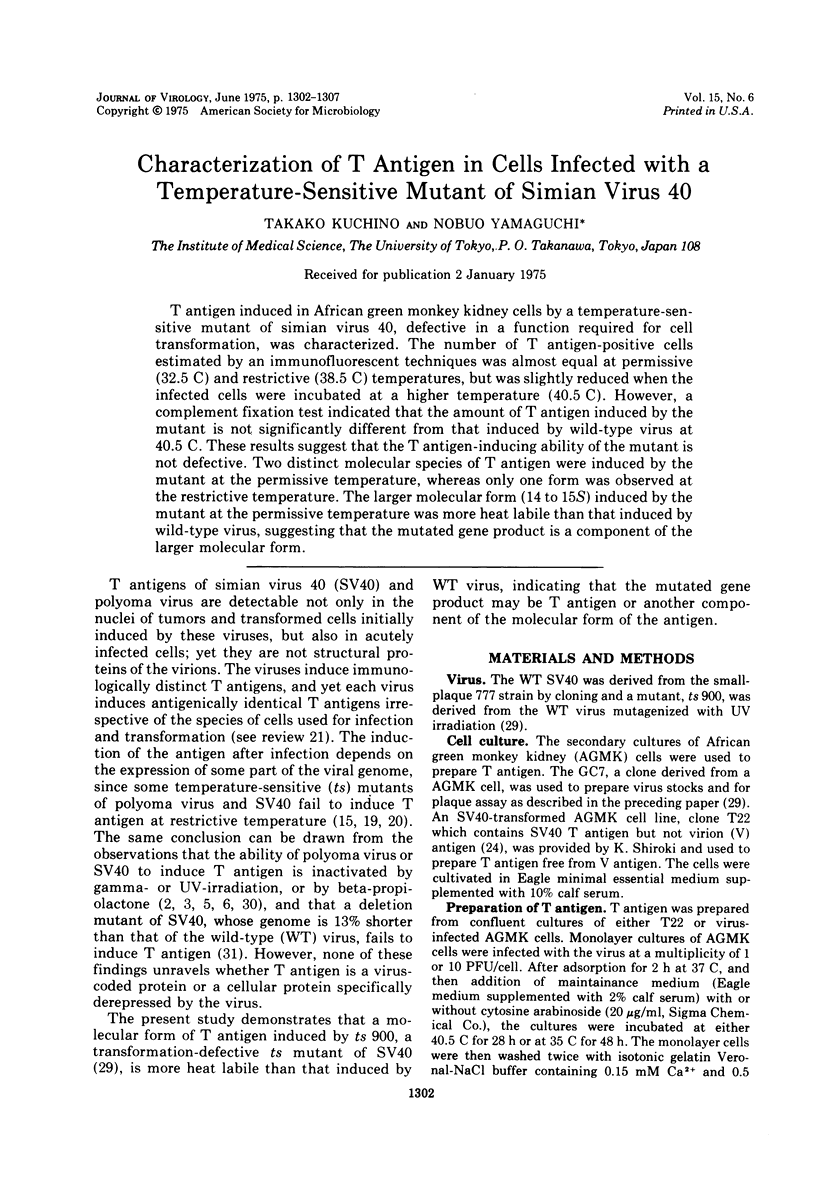

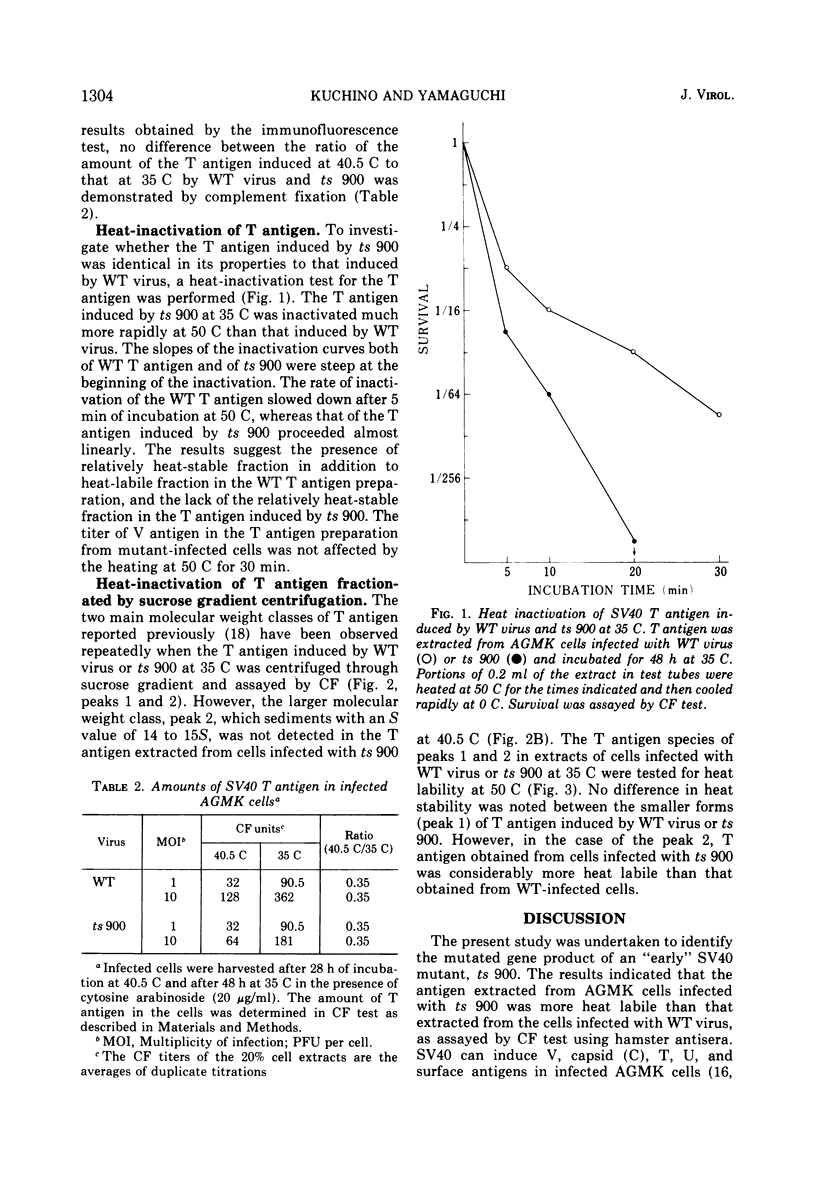
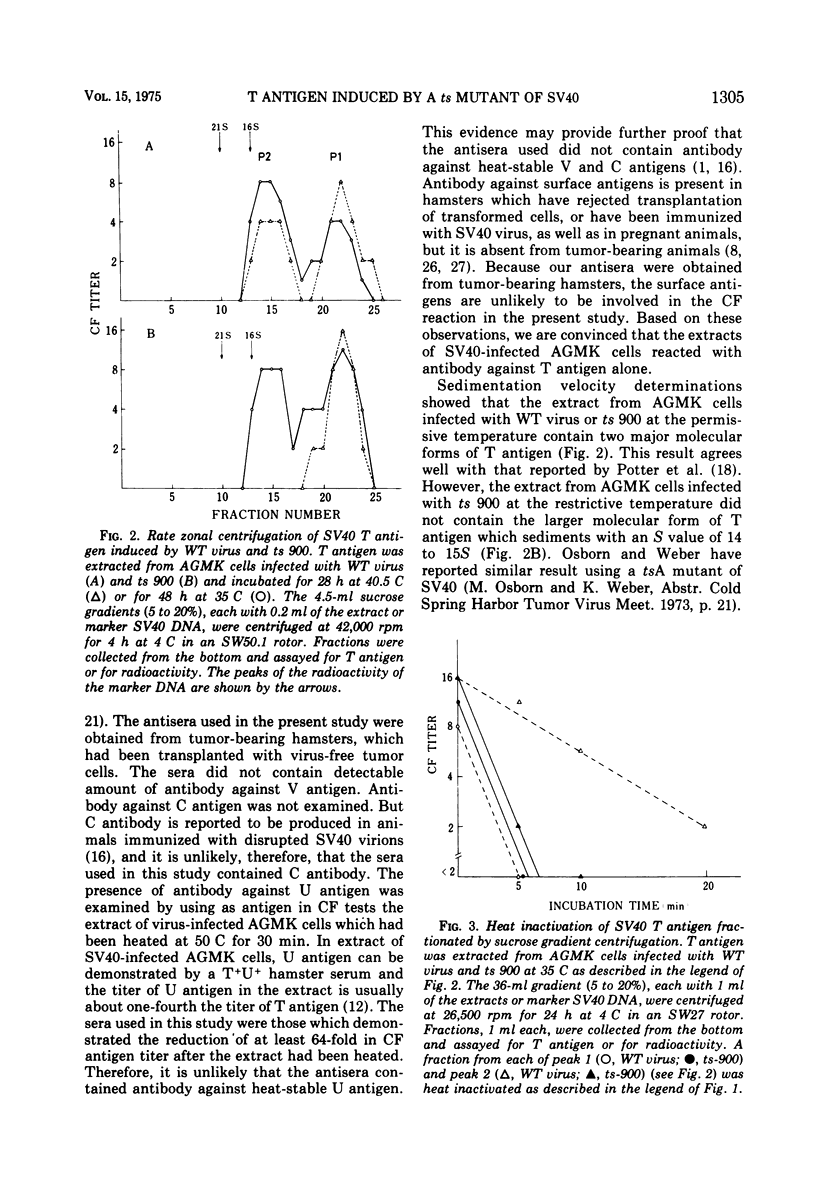
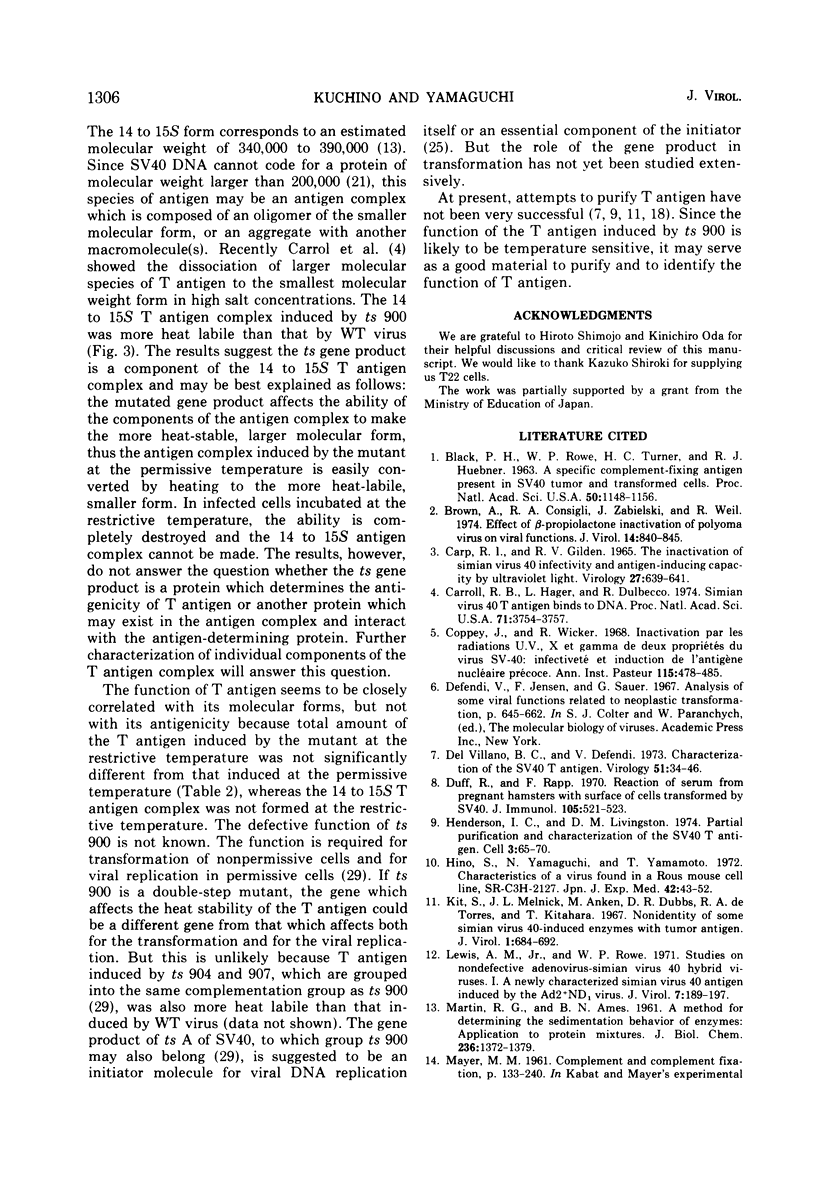
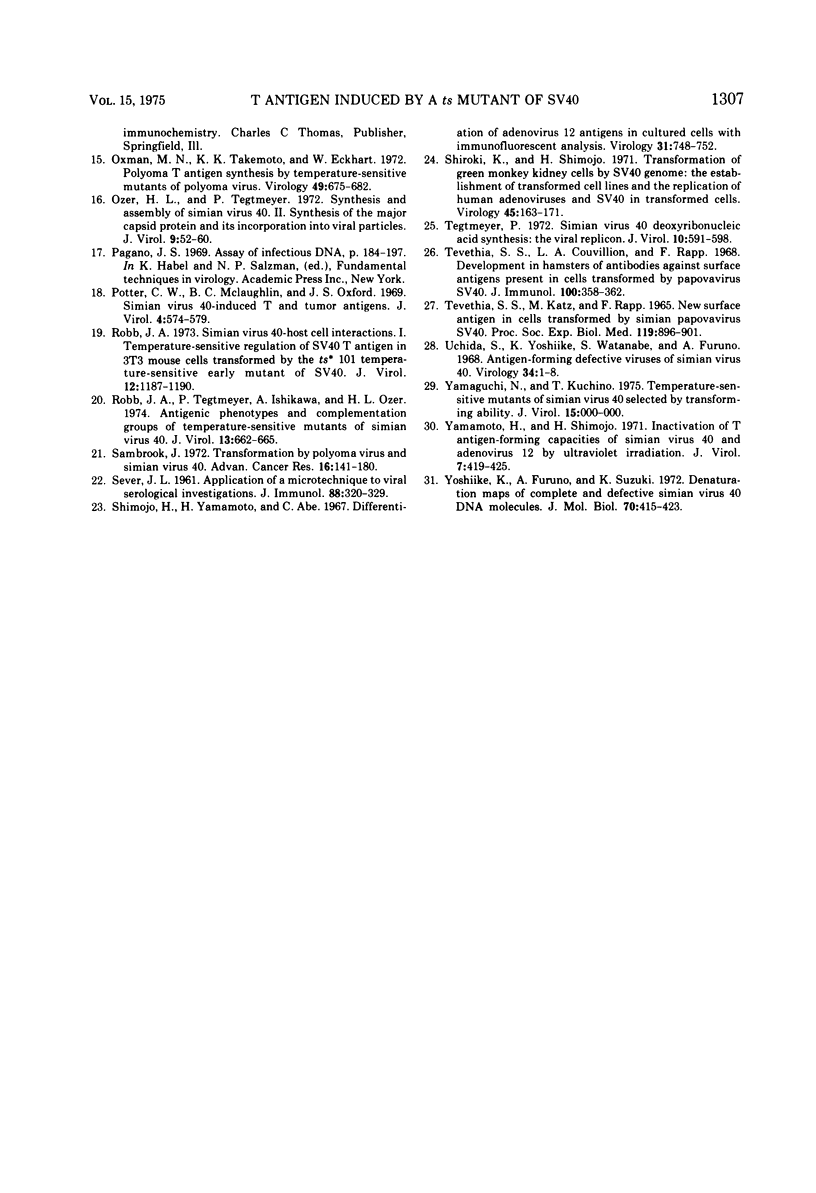
Selected References
These references are in PubMed. This may not be the complete list of references from this article.
- BLACK P. H., ROWE W. P., TURNER H. C., HUEBNER R. J. A SPECIFIC COMPLEMENT-FIXING ANTIGEN PRESENT IN SV40 TUMOR AND TRANSFORMED CELLS. Proc Natl Acad Sci U S A. 1963 Dec;50:1148–1156. doi: 10.1073/pnas.50.6.1148. [DOI] [PMC free article] [PubMed] [Google Scholar]
- Brown A., Consigli R. A., Zabielski J., Weil R. Effect of beta-propiolactone inactivation of polyoma virus on viral functions. J Virol. 1974 Oct;14(4):840–845. doi: 10.1128/jvi.14.4.840-845.1974. [DOI] [PMC free article] [PubMed] [Google Scholar]
- Carp R. I., Gilden R. V. The inactivation of simian virus 40 infectivity and antigen-inducing capacity by ultraviolet light. Virology. 1965 Dec;27(4):639–641. doi: 10.1016/0042-6822(65)90194-7. [DOI] [PubMed] [Google Scholar]
- Carroll R. B., Hager L., Dulbecco R. Simian virus 40 T antigen binds to DNA. Proc Natl Acad Sci U S A. 1974 Sep;71(9):3754–3757. doi: 10.1073/pnas.71.9.3754. [DOI] [PMC free article] [PubMed] [Google Scholar]
- Coppey J., Wicker R. Inactivation par les radiations U.V., X et gamma de deux propriétés du virus SV-40: infectivité et induction de l'antigène nucléaire précoce. Ann Inst Pasteur (Paris) 1968 Sep;115(3):478–485. [PubMed] [Google Scholar]
- Del Villano B. C., Defendi V. Characterization of the SV40 T antigen. Virology. 1973 Jan;51(1):34–46. doi: 10.1016/0042-6822(73)90363-2. [DOI] [PubMed] [Google Scholar]
- Duff R., Rapp F. Reaction of serum from pregnant hamsters with surface of cells transformed by SV40. J Immunol. 1970 Aug;105(2):521–523. [PubMed] [Google Scholar]
- Henderson I. C., Livingston D. M. Partial purification and characterization of the SV40 T antigen. Cell. 1974 Sep;3(1):65–70. doi: 10.1016/0092-8674(74)90041-5. [DOI] [PubMed] [Google Scholar]
- Hino S., Yamaguchi N., Yamamoto T. Characteristics of a virus found in a Rous mouse cell line, SR-C3H-2127. Jpn J Exp Med. 1972 Feb;42(1):43–52. [PubMed] [Google Scholar]
- Kit S., Melnick J. L., Anken M., Dubbs D. R., De Torres R. A., Kitahara T. Nonidentiy of some simian virus 40-induced enzymes with tumor antigen. J Virol. 1967 Aug;1(4):684–692. doi: 10.1128/jvi.1.4.684-692.1967. [DOI] [PMC free article] [PubMed] [Google Scholar]
- Lewis A. M., Jr, Rowe W. P. Studies on nondefective adenovirus-simian virus 40 hybrid viruses. I. A newly characterized simian virus 40 antigen induced by the Ad2+ND 1 virus. J Virol. 1971 Feb;7(2):189–197. doi: 10.1128/jvi.7.2.189-197.1971. [DOI] [PMC free article] [PubMed] [Google Scholar]
- MARTIN R. G., AMES B. N. A method for determining the sedimentation behavior of enzymes: application to protein mixtures. J Biol Chem. 1961 May;236:1372–1379. [PubMed] [Google Scholar]
- Oxman M. N., Takemoto K. K., Eckhart W. Polyoma T antigen synthesis by temperature-sensitive mutants of polyoma virus. Virology. 1972 Sep;49(3):675–682. doi: 10.1016/0042-6822(72)90524-7. [DOI] [PubMed] [Google Scholar]
- Ozer H. L., Tegtmeyer P. Synthesis and assembly of simian virus 40. II. Synthesis of the major capsid protein and its incorporation into viral particles. J Virol. 1972 Jan;9(1):52–60. doi: 10.1128/jvi.9.1.52-60.1972. [DOI] [PMC free article] [PubMed] [Google Scholar]
- Potter C. W., McLaughlin B. C., Oxford J. S. Simian virus 40-induced T and tumor antigens. J Virol. 1969 Nov;4(5):574–579. doi: 10.1128/jvi.4.5.574-579.1969. [DOI] [PMC free article] [PubMed] [Google Scholar]
- Robb J. A. Simian virus 40-host cell interactions. I. Temperature-sensitive regulation of SV40 T antigen in 3T3 mouse cells transformed by the ts*101 temperature-sensitive early mutant of SV40. J Virol. 1973 Nov;12(5):1187–1190. doi: 10.1128/jvi.12.5.1187-1190.1973. [DOI] [PMC free article] [PubMed] [Google Scholar]
- Robb J. A., Tegtmeyer P., Ishikawa A., Ozer H. L. Antigenic phenotypes and complementation groups of temperature-sensitive mutants of simian virus 40. J Virol. 1974 Mar;13(3):662–665. doi: 10.1128/jvi.13.3.662-665.1974. [DOI] [PMC free article] [PubMed] [Google Scholar]
- SEVER J. L. Application of a microtechnique to viral serological investigations. J Immunol. 1962 Mar;88:320–329. [PubMed] [Google Scholar]
- Sambrook J. Transformation by polyoma virus and simian virus 40. Adv Cancer Res. 1972;16:141–180. [PubMed] [Google Scholar]
- Shimojo H., Yamamoto H., Abe C. Differentiation of adenovirus 12 antigens in cultured cells with immunofluorescent analysis. Virology. 1967 Apr;31(4):748–752. doi: 10.1016/0042-6822(67)90213-9. [DOI] [PubMed] [Google Scholar]
- Shiroki K., Shimojo H. Transformation of green monkey kidney cells by SV40 genome: the establishment of transformed cell lines and the replication of human adenoviruses and SV40 in transformed cells. Virology. 1971 Jul;45(1):163–171. doi: 10.1016/0042-6822(71)90123-1. [DOI] [PubMed] [Google Scholar]
- TEVETHIA S. S., KATZ M., RAPP F. NEW SURFACE ANTIGEN IN CELLS TRANSFORMED BY SIMIAN PAPOVAVIRUS SV40. Proc Soc Exp Biol Med. 1965 Jul;119:896–901. doi: 10.3181/00379727-119-30330. [DOI] [PubMed] [Google Scholar]
- Tegtmeyer P. Simian virus 40 deoxyribonucleic acid synthesis: the viral replicon. J Virol. 1972 Oct;10(4):591–598. doi: 10.1128/jvi.10.4.591-598.1972. [DOI] [PMC free article] [PubMed] [Google Scholar]
- Tevethia S. S., Couvillionla, Rapp F. Development in hamsters of antibodies against surface antigens present in cells transformed by papovavirus SV40. J Immunol. 1968 Feb;100(2):358–362. [PubMed] [Google Scholar]
- Yamamoto H., Shimojo H. Inactivation of T antigen-forming capacites of simian virus 40 and adenovirus 12 by ultraviolet irradiation. J Virol. 1971 Apr;7(4):419–425. doi: 10.1128/jvi.7.4.419-425.1971. [DOI] [PMC free article] [PubMed] [Google Scholar]
- Yoshiike K., Furuno A., Suzuki K. Denaturation maps of complete and defective simian virus 40 DNA molecules. J Mol Biol. 1972 Oct 14;70(3):415–423. doi: 10.1016/0022-2836(72)90549-9. [DOI] [PubMed] [Google Scholar]


